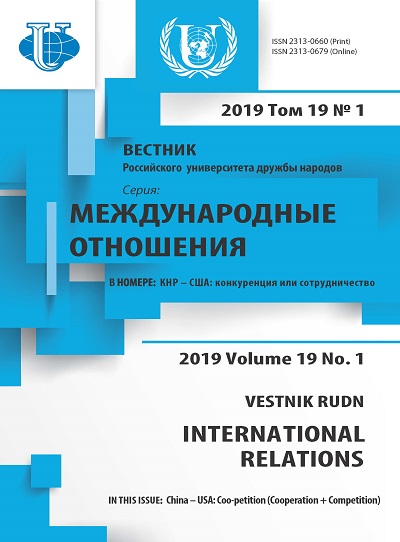China in D. Trump’s Free and Open Indo-Pacific Strategy
- 作者: Leksyutina Y.V.1
-
隶属关系:
- Saint-Petersburg State University
- 期: 卷 19, 编号 1 (2019): China — USA: Coo-petition (Cooperation + Competition)
- 页面: 22-34
- 栏目: THEMATIC DOSSIER
- URL: https://journals.rudn.ru/international-relations/article/view/20849
- DOI: https://doi.org/10.22363/2313-0660-2019-19-1-22-34
- ID: 20849
如何引用文章
全文:
详细
With Trump as a president of the US from January 2017 and his decisive actions, which have undermined many agreements reached by previous American administrations (like withdrawal from the TTP, the Paris climate agreement, the Iran nuclear deal, the UNESCO, etc.), the international system and regional subsystems are under serious reconfiguration and readjustments. This accentuates the necessity to systemize Trump’s actions and initiatives in the realm of foreign policy and foreign trade, to interpret these actions’ logic, and to evaluate the changes that Trump’s policies have brought about. It is of high importance to analyze Trump’s strategy in the Indo-Pacific which is the priority region in his foreign policy agenda and the region where two major threats to the US and its allies are coming from - the rise of China as a country that pursues unfair trade and economic policies and reveals assertiveness in securing its core interests, and the threat from the North Korea. The aim of the article is to analyze China’s place in Trump’s Indo-Pacific strategy. By studying American conceptual documents, Trump’s and other American high-level officials’ speeches, the article characterizes Trump’s free and open Indo-Pacific strategy, reveals its commonalities and peculiarities vis-à-vis Obama’s rebalancing to the Asia-Pacific strategy. The article also addresses the issue of Trump’s policies in the region on the economic front, because this is where Trump administration has introduces dramatic changes. Trump’s Indo-Pacific strategy is examined in the article in the context of its impact on the US-China relations. The relations between the two countries - without exaggeration, one of the most consequential for the world - may seriously deteriorate due to not only the evolving US-China trade war, but also contradictions between them over various issues in the IndoPacific region. The article analyzes the aggravation of tensions between the US and China in 2017-2018 over South and East China Seas, Taiwan issue, and North Korea issue.
作者简介
Yana Leksyutina
Saint-Petersburg State University
编辑信件的主要联系方式.
Email: lexyana@ya.ru
Doctor of Political Sciences, Professor of the Russian Academy of Sciences, Professor of the American Studies Department, Saint-Petersburg State University
参考
- Auslin, M. (2018). The Question of American Strategy in the Indo-Pacific. Hoover Institution, 2018. URL: https://www.hoover.org/sites/default/files/research/docs/auslin_webreadypdf.pdf (accessed: 03.12.2018).
- Chen, Dingding. (2018). The Indo-Pacific Strategy: A Background Analysis. URL: https://www.ispionline.it/it/pubblicazione/ indo-pacific-strategy-background-analysis-20714 (accessed: 03.10.2018).
- Davydov, A.S. (2018). 19th CPC National Congress and the Sino-American relations. In: Decision of the 19th CPC National Congress and the perspectives of the Russia-China relations. Ed. by S.G. Luzyanin. Moscow: IFES RAS, p. 54—65. (In Russian).
- Glaser, B. & Flaherty, K. (2018). US—China Relations: Tit-for-Tat Tariffs. Comparative Connections, 20 (2), 21—36. URL: http://cc.pacforum.org/2018/09/tit-for-tat-tariffs/ (accessed: 09.10.2018).
- Hong, Zhao (2008). China and India: competing for good relations with Myanmar. The Journal of East Asian Affairs, 22 (1), 175—194.
- Jia, Xiudong (2018). US Indo-Pacific strategy is not what it appears to be. URL: http://www.ciis.org.cn/english/201806/12/content_40380664.htm (accessed: 10.10.2018).
- Kistanov, V.O. (2018). Japan’s Indo-Pacific Strategy as a Deterrent to China. Far Eastern Affairs, 2, 32—43. (In Russian).
- Koldunova, E. (2018). Russia and the Turbulent Waters of the Indo-Pacific. Regional Security Outlook 2019, 18—20. URL: http://www.cscap.org/uploads/docs/CRSO/CSCAP%202019%20Regional%20Security%20Outlook.pdf?fbclid= IwAR1oy3th2ForvUFJ0hJndnok2Ar3d8eXEHmPw_ dRiVKgsHqPUEwNd00u1Y (accessed: 02.12.2018).
- Kuznetsov, D.V. (2017). About the Relationships between the US and China in the Initial Period of Trump’s Presidency. Far Eastern Affairs, 5, 32—46. (In Russian).
- Le Hong Hiep (2018). America’s Free and Open Indo-Pacific Strategy: A Vietnamese Perspective. ISEAS Perspective, 43. URL: https://www.iseas.edu.sg/images/pdf/ISEAS_Perspective_ 2018_43@50.pdf (accessed: 02.12.2018).
- Leksyutina, Ya.V. (2014). Obama’s “Return to Asia” Strategy: Five Years of Its Implementation. USA—Canada: economics, politics, culture, 10, 17—34. (In Russian).
- Lokshin, G.М. (2018). Trump's Doctrine as a Course to Create a New Bloc in Asia. Far Eastern Affairs, 3, 4—18. (In Russian).
- Manning, R. (2018). US Indo-Pacific Strategy: Myths and Reality. Valdai paper, 89. URL: http://valdaiclub.com/ a/valdai-papers/valdai-paper-89-us-indo-pacific-strategy/ (accessed: 01.12.2018).
- Scott, D. (2018). The Indo-Pacific in US Strategy: Responding to Power Shifts. Rising powers quarterly, 3 (2), 19—43. URL: http://risingpowersproject.com/quarterly/the-indo-pacific-in-us-strategy-responding-to-power-shifts/ (accessed: 09.10.2018).
- Smith, J. (2018). Another First: U.S. and India to Hold 2+2 Dialogue in Delhi. Issue Brief, 4897. URL: https://www.heritage.org/ sites/default/files/2018-08/IB4897.pdf (accessed: 09.10.2018).
- Streltsov, D. (2018). The Indo-Pacific region as a new reality of the global system of international relations. International Affairs, 9, 65—74. (In Russian).
- Tao, Wenzhao (2013). Review of the Obama Administration’s Taiwan policy. Contemporary International Relations, 24 (1), 92—113.
- Trush, S.М. (2017). USA—China Relations at the Milestone Between Obama and Trump: Political and Military-Political Dimension. USA—Canada: economics, politics, culture, 3 (567), 54—55. (In Russian).
- Zhao, Huansheng (2018). The Indo-Pacific Strategy: China’s Perspective. Valdai Discussion Club. URL: http://valdaiclub.com/ a/highlights/the-indo-pacific-strategy-china-s-perspective/ (accessed: 03.12.2018).
补充文件








